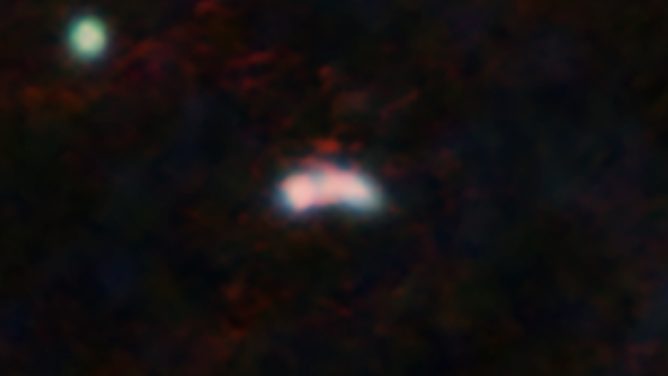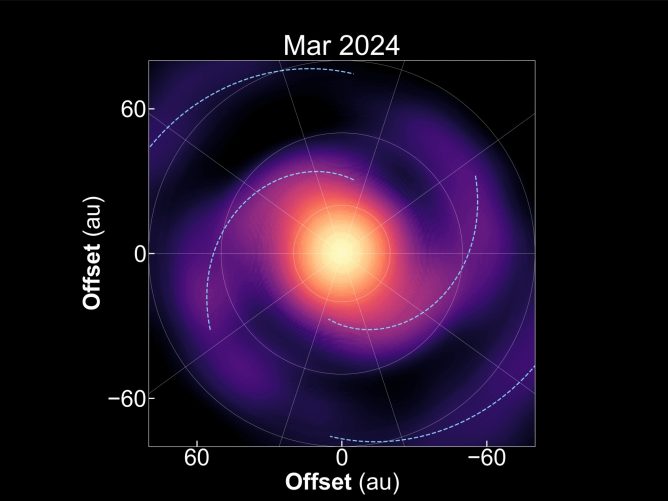New images taken with the Atacama Large Millimeter/submillimeter Array (ALMA) reveal surprising details of the Sun, including the dark, contorted center of an evolving sunspot nearly twice the diameter of the Earth.
ALMA has demonstrated unprecedented capability to explore the cool Universe and has presented stunning images of distant galaxies and planet-forming disks around nearby young stars. However, the Sun, the closest star to us, is also an important target for ALMA. By imaging the Sun with millimeter-wavelength radio waves, researchers can measure the temperature variations in the Sun’s chromosphere – the region of the Sun’s atmosphere that lies just above the visible surface of the Sun, known as the photosphere.
Since our Sun is many billions of times brighter than the faint objects ALMA typically observes, the team of astronomers had to develop special procedures to enable ALMA to safely image the Sun without damaging its sensitive electronics and precisely measure the intensity of the solar radio waves. The new images are part of the testing and verification campaign to make ALMA’s solar observing capabilities available to the international astronomical community.
The team observed a sunspot at wavelengths of 1.25 millimeters and 3 millimeters. The images reveal differences in temperature between parts of the Sun’s chromosphere. Sunspots are transient features that occur in regions where the Sun’s magnetic field is extremely concentrated and powerful. They are lower in temperature than their surroundings, which is why they appear relatively dark. The ALMA image is essentially a map of temperature differences in a layer of the chromosphere. The chromosphere is considerably hotter than the photosphere. Understanding the heating and dynamics of the chromosphere are key areas of research that will be addressed in the future using ALMA.
The result of this work is a series of images that demonstrates ALMA’s unique vision and ability to study our Sun on multiple scales.
“Although our Sun is the nearest star, many puzzles are still remained”, told Masumi Shimojo, an assistant professor at NAOJ and the leader of interferometric test in the solar commissioning team. “To solve them, we have been observing the Sun with wide spectral range, from radio to gamma-ray, for long time. However, mm/sub-mm solar observations with high resolution are an unknown world for solar physics. I hope to discover new phenomena and physics from ALMA solar data and progress our understanding of the Sun.”
NAOJ, which represents Japan and East Asia in ALMA, has a long history in solar observations. The NAOJ Solar Observatory in Tokyo operates several telescopes to image the entire Sun in optical and infrared light. The solar observing satellite HINODE, operated through collaboration involving NAOJ, JAXA, NASA, ESA, and the UK, carries three advanced telescopes and acquires solar images in X-ray, ultraviolet, and optical light. In radio wavelengths, the Nobeyama Radio Heliograph, now operated by Nagoya University, monitors the entire Sun. By combining all these observations, astronomers strive to achieve a comprehensive understanding of the Sun.

Figure 3. This image of the entire solar disk was taken in the red visible light emitted by iron atoms in the Sun’s atmosphere. Light at this wavelength originates from the visible solar surface, the photosphere. A cooler, darker sunspot is clearly visible on the disk. For visual comparison, the image from ALMA at a wavelength of 1.25 millimeters is shown in the inset.
The full-disk solar image was taken with the Helioseismic and Magnetic Imager (HMI) onboard NASA’s Solar Dynamics Observatory (SDO).
ALMA (ESO/NAOJ/NRAO), NASA
The ALMA Solar Campaign team includes Shin’ichiro Asayama; Miroslav Barta; Tim Bastian; Roman Brajsa; Bin Chen; Bart De Pontieu; Gregory Fleishman; Dale Gary; Antonio Hales; Akihiko Hirota; Hugh Hudson; Richard Hills; Kazumasa Iwai; Sujin Kim; Neil Philips; Tsuyoshi Sawada; Masumi Shimojo (interferometry lead); Giorgio Siringo; Ivica Skokic; Sven Wedemeyer; Stephen White (single dish lead); Pavel Yagoubov; and Yihua Yan.









